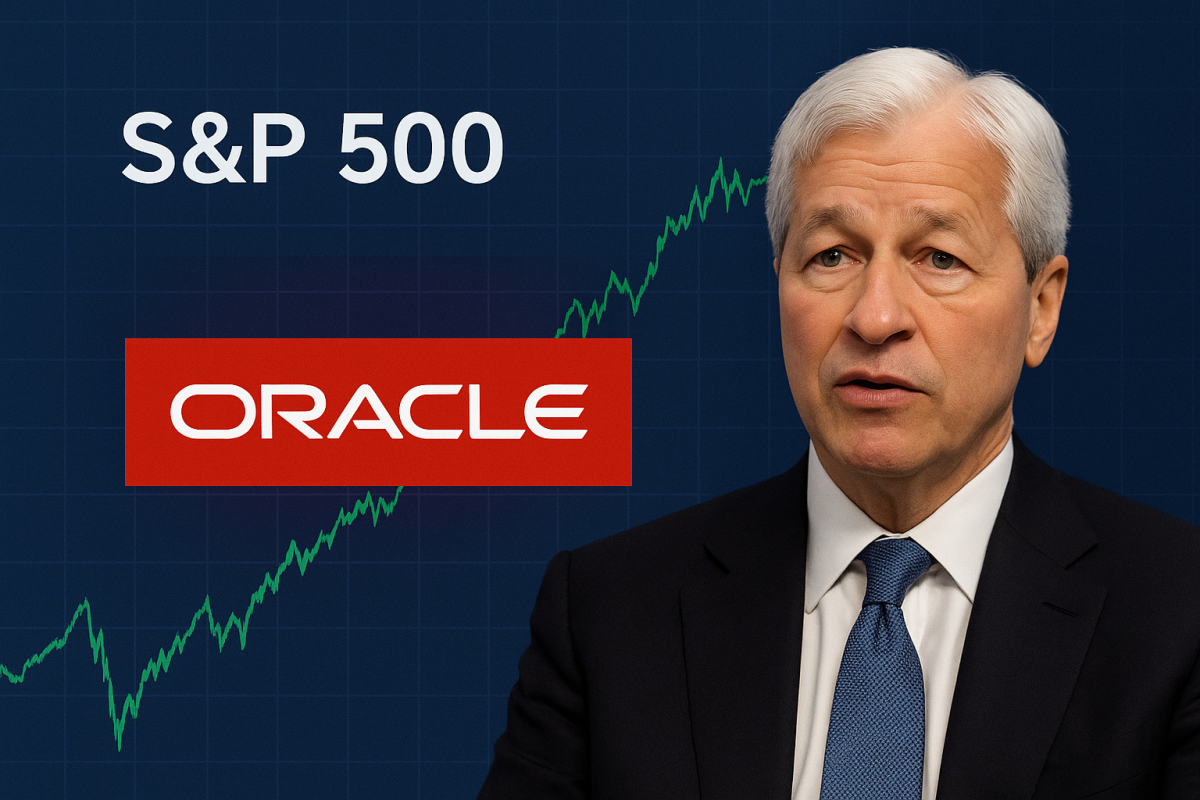The stock market is riding a fine line between optimism and anxiety. On October 9, 2025, the S&P 500 hovered near record highs, but signs of volatility began to surface. With the index’s three-month volatility reading climbing to 19.71, investors are growing uneasy about what lies ahead.
At the same time, Oracle’s unexpected slump following a disappointing report on its AI cloud margins and JPMorgan CEO Jamie Dimon’s stark warning of a possible 30 percent correction have deepened the sense of caution across Wall Street.
These developments are not isolated. Together, they paint a picture of a market balancing strong performance against growing concerns about valuation, profitability, and geopolitical uncertainty.
This article examines the factors driving current market turbulence, including S&P 500 volatility, Oracle’s setback, and Dimon’s warning. It also explores what investors can learn from these events and how to position themselves for the months ahead.
S&P 500: Volatility Returns After Record Highs
The S&P 500 has been the centerpiece of market optimism in 2025. On October 7, the index reached a record close near 6,000, rising almost 10 percent year-to-date, including dividends. The benchmark has reflected investor confidence in economic resilience and corporate earnings.
However, recent weeks have introduced signs of uncertainty. The CBOE’s three-month Volatility Index ticked up to 19.71, suggesting that investors are bracing for choppier trading sessions in the months ahead. While far below the panic levels seen during the 2020 pandemic crash, this uptick points to renewed caution.
Several factors are driving the rise in volatility. Throughout the year, markets have reacted sharply to tariff negotiations, shifting fiscal policies, and changing interest rate expectations. The 10-year Treasury yield has also moved in tandem with equities, reflecting a sensitive macroeconomic environment.
In September, the S&P 500 gained 3.5 percent, bringing its year-to-date performance to 13.7 percent. Yet analysts warn that earnings growth among large-cap technology companies is far outpacing the broader index. Goldman Sachs projects a 10 percent return for the year, with earnings per share expected to reach $268. Still, the firm highlights potential risks from elevated valuations, with the index trading at a price-to-earnings ratio of 21.7, placing it in the 93rd percentile historically.
Market breadth also remains uneven. The so-called “Magnificent 7” tech giants have carried much of the market’s momentum, while sectors such as semiconductors, healthcare, and consumer staples have struggled to match those gains. Communication services lead year-to-date with more than 17 percent growth, while healthcare has slipped slightly into negative territory.
Analysts note that this concentration of growth makes the index more vulnerable to sharp pullbacks. The current environment underscores the importance of diversification, especially as investors rotate toward sectors like materials and energy that may benefit from global infrastructure demand and AI-related power needs.
For many investors, this period of volatility represents both risk and opportunity. Short-term traders are watching volatility indexes and futures markets for hedging signals, while long-term investors are focusing on resilient sectors and maintaining diversified portfolios.
Oracle’s AI Slump: A Reality Check for Tech Investors
Oracle’s sudden stock decline has sent shockwaves through the technology sector. After an impressive 36 percent surge on September 10 — its best single-day performance in decades the company’s shares fell by more than 7 percent on October 7, erasing around $20 per share.
The drop followed a report from The Information revealing that Oracle’s AI cloud division generated approximately $900 million in Nvidia-powered server rentals in the quarter ending in August but earned only $125 million in gross profit. That represents a thin 14 percent margin, much lower than analysts had anticipated.
The revelation triggered a swift reassessment of Oracle’s ambitious AI growth story. The company had previously projected that its cloud infrastructure revenue could grow from $18 billion in fiscal 2026 to $144 billion by 2030. CEO Safra Catz had also emphasized Oracle’s technological advantages over competitors like Amazon Web Services and Microsoft Azure.
However, the report highlighted key challenges, including high operational costs, energy expenses, and hardware depreciation. These factors raise questions about whether Oracle’s AI-driven expansion can maintain profitability at scale.
Some analysts, such as those at Stifel, still view the decline as a buying opportunity, expecting margins to recover over time. Yet the broader market reaction reflects a growing skepticism toward the AI boom. Investors are beginning to separate hype from sustainable profit models.
Oracle’s experience serves as a warning for the broader technology sector. It shows how quickly sentiment can shift when high expectations meet disappointing financial realities. The company’s stock, which traded above $310 after earnings, now faces support around $280. Analysts project potential recovery if profitability improves, but the near-term outlook remains uncertain.
More importantly, Oracle’s slump has tempered enthusiasm across the AI space. Nvidia and other related stocks have also seen minor pullbacks as investors reexamine the profitability of AI infrastructure spending. The lesson is clear: not all growth driven by artificial intelligence will translate into consistent returns.
Jamie Dimon’s Warning: A 30 Percent Correction Could Be Coming
When Jamie Dimon speaks, markets listen. The long-serving JPMorgan Chase CEO recently warned that U.S. stocks could face a correction of up to 30 percent within the next two years.
Speaking in an interview with the BBC, Dimon cited several major risks, including growing geopolitical tensions, high fiscal deficits, and what he described as excessive optimism surrounding artificial intelligence investments.
“I’m far more worried than others,” Dimon said, adding that investors should prepare for the possibility that many AI-driven bets could fail to deliver expected returns.
His comments come at a time when valuations across major U.S. indexes remain stretched. Credit spreads are tight, and asset prices appear inflated, leaving little cushion if growth slows. Dimon’s remarks also follow his earlier warnings about potential economic disruptions stemming from tariff conflicts and global supply chain constraints.
Historically, Dimon’s market calls have carried weight. He was among the few major banking executives to anticipate the 2008 financial crisis and has consistently emphasized the importance of financial resilience.
His latest caution aligns with concerns voiced by other institutions, including the Bank of England, which has warned that AI-related valuations could face a sudden correction similar to the dot-com bubble of the late 1990s.
For investors, Dimon’s advice is not about fear but preparation. He recommends diversification, hedging with options, and maintaining exposure to quality bonds and cash reserves. In a high-valuation environment, protecting downside risk becomes just as important as capturing upside potential.
The Bigger Picture: How These Events Interconnect
The rise in S&P volatility, Oracle’s AI profit challenges, and Dimon’s correction warning are connected by a common thread inflated expectations meeting economic reality.
Technology now represents nearly 30 percent of the S&P 500’s total market capitalization. When a major company like Oracle stumbles, its impact extends far beyond a single stock. Combined with signs of economic fatigue and policy uncertainty, these factors create an environment where market sentiment can shift rapidly.
Earnings season will likely determine whether optimism returns or caution deepens. Analysts expect earnings growth to slow for the majority of S&P 500 companies, with the “S&P 493” all members excluding the biggest tech firms projected to deliver around 6 percent growth compared to 30 percent among megacaps.
At the same time, global developments continue to influence risk perception. Tariff disputes, energy market volatility, and shifts in monetary policy all have the potential to amplify market swings.
Still, there are reasons for optimism. U.S. GDP growth remains strong, and inflation pressures have eased compared to 2023 levels. A more accommodative Federal Reserve stance could also provide stability. Additionally, emerging markets are beginning to attract renewed investor interest as currencies strengthen and bond yields remain favorable.
Investor Strategies for a Shifting Market
To navigate this evolving landscape, investors should adopt strategies that emphasize balance and long-term thinking:
1. Diversify portfolios across sectors. Reducing concentration in technology and adding exposure to energy, materials, and financials can improve stability.
2. Use volatility as a tool, not a threat. Strategic hedging through low-cost ETFs or options can help manage short-term market swings.
3. Focus on companies with strong fundamentals. Prioritize firms with consistent profit margins above 20 percent, stable cash flow, and manageable debt.
4. Watch key support levels. For the S&P 500, analysts are watching support around 5,800. A break below that level could confirm a deeper correction.
5. Keep a long-term mindset. Historical data shows that most market corrections, while painful, are temporary. Investors who stay patient and disciplined often outperform those who panic-sell during volatility.
Staying Grounded Amid the Uncertainty
The combination of rising S&P volatility, Oracle’s disappointing AI margins, and Jamie Dimon’s correction warning underscores the importance of vigilance. Markets remain near record highs, but the underlying conditions reveal fragility.
These developments are not signs of collapse but reminders that caution and preparation matter more than ever. The key takeaway for investors is to stay diversified, avoid chasing hype, and build portfolios that can withstand economic shifts.
As markets continue to evolve through the final quarter of 2025, one truth remains clear: the most successful investors are those who stay informed, flexible, and focused on long-term value rather than short-term excitement.

